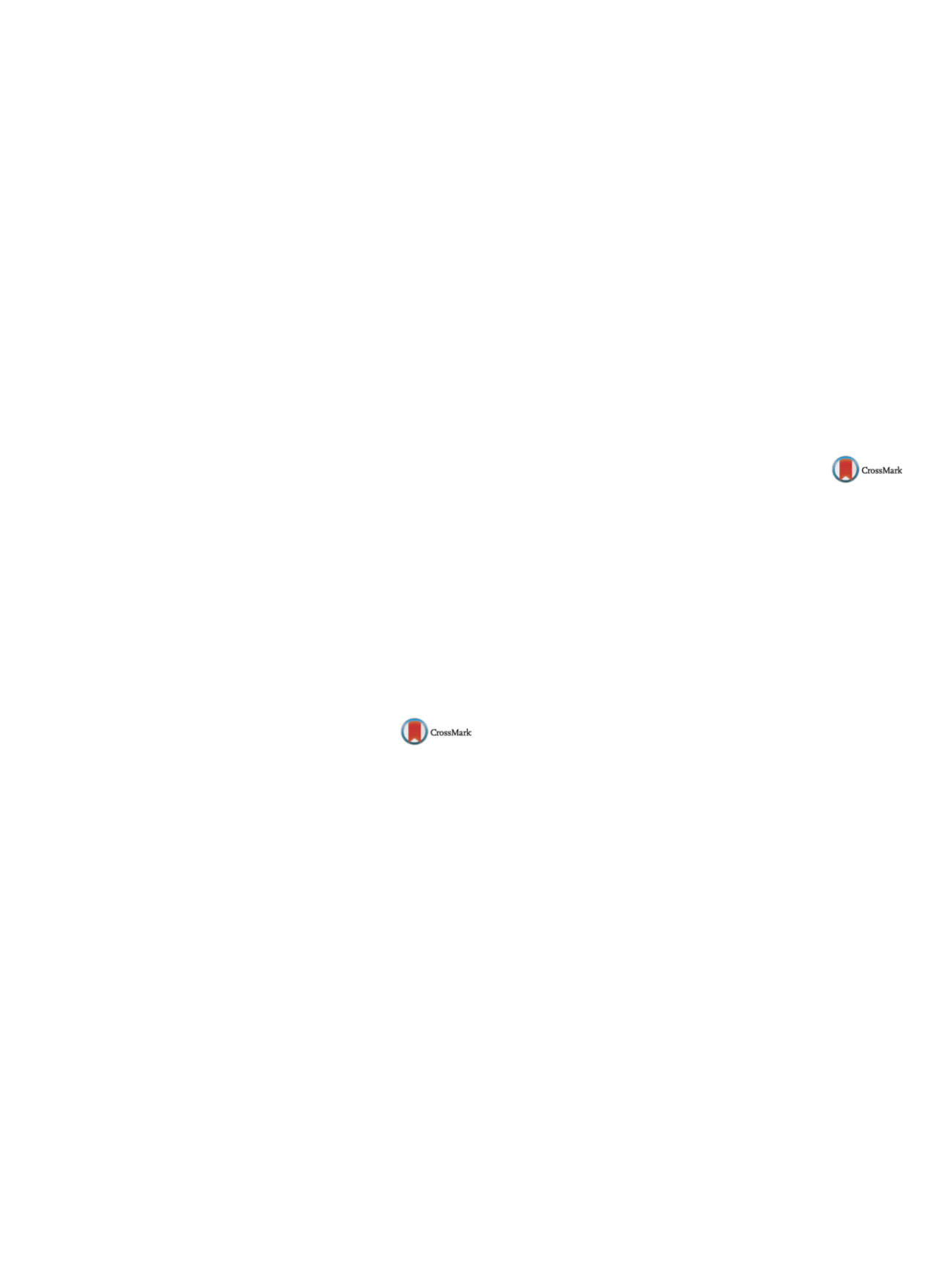

25th European Congress of Psychiatry / European Psychiatry 41S (2017) S303–S364
S351
2
Psychiatry, National mental health research centre of the Russian
academy of medical sciences, Moscow, Russia
∗
Corresponding author.
Introduction
The aim of the study was to analyze the microstruc-
tural and metabolic features of the corpus callosum in recently
onset schizophrenia.
Objectives
13 young (17–28 years old) male patients with
recently onset schizophrenia (F20, ICD-10) and 15 sex and age mat-
ched mentally healthy subjects were examined.
Methods
3 T Philips Achieva scanner with 8-channel SENSE coil
was used. DTI was conducted with EPI SENSE (TR = 9431ms;
TE = 70 ms). The values of diffusion coefficient (ADC), fractio-
nal anisotropy (FA), radial (RD) and parallel (PD) diffusivity
were calculated using workstation Philips EBWS 2.6.3.4. Spec-
troscopic voxel (2
×
1
×
1 cm) was placed consequently in the
corpus callosum genu and splenium. PRESS (TR/TE = 1500/40) was
used.
Results
In patients, increased ADC (
P
= 0.02) and RD (
P
= 0.008),
decreased FA (
P
= 0.008) and NAA (
P
= 0.03) were found in the cor-
pus callosum genu, No intergroup differences by PD, Cho, Cr, Glx
were found in this area. Also, no statistically significant intergroup
differences were observed for the DTI and MRS characteristics of
the corpus callosum splenium.
Conclusions
It has been shown that RD increase is associated
with demyelination process. So, an increase of RD in the present
study could reflect demyelination in CC genu. Cells membranes
abnormalities should lead to an increase of Cho which was not
found. NAA reduction could be caused by reduction of axonal
integrity. The latter process is considered to precede demyelina-
tion and not to be accompanied by PD rise. Thus, the present
study revealed axonal integrity reduction and low demyelina-
tion in the genu of the corpus callosum in the early stages of
schizophrenia.
Disclosure of interest
The authors have not supplied their decla-
ration of competing interest.
http://dx.doi.org/10.1016/j.eurpsy.2017.02.327EW0714
Frontal cortex myo-inositol is
associated with sleep and depression
in adolescents : A proton magnetic
resonance spectroscopy study
A.S. Urrila
∗
, a, A. Hakkarainen
b, A. Castaneda
c, T. Paunio
d,
M. Marttunen
a, N. Lundbom
ba
National institute for health and welfare THL, department of
health/mental health, Helsinki, Finland
b
HUS Helsinki medical imaging center, radiology, Helsinki, Finland
c
National institute for health and welfare, department of welfare,
equality and inclusion unit, Helsinki, Finland
d
National institute for health and welfare, department of genetics
and biomarkers, Helsinki, Finland
∗
Corresponding author.
Aim
This study used proton magnetic resonance spectroscopy
(
1
H MRS) to evaluate neurochemistry of the frontal cortex in ado-
lescents with symptoms of sleep and depression.
Methods
19 non-medicated adolescent boys (mean age 16.0 y;
n
= 9 clinical cases with depression/sleep symptoms and
n
= 10
healthy controls) underwent
1
H MRS at 3 T. MR spectra were
acquired from the anterior cingulate cortex (ACC), the dorsolate-
ral prefrontal cortex, and frontal white matter. Concentrations of
N-acetyl aspartate, total creatine, choline-containing compounds,
total glutamine plus glutamate, and myo-inositol (mI) were com-
pared between the two subgroups and correlated with sleep
and clinical measures in the total sample. Sleep was assessed
with self-report questionnaires and ambulatory polysomnography
recordings.
Results
Concentrations of mI were lower in both frontal cortical
regions among the depressed adolescents as compared to healthy
controls. No statistically significant differences in other metabo-
lite concentrations were observed between the subgroups. Frontal
cortex mI concentrations correlated negatively with depression
severity, subjective daytime sleepiness, insomnia symptoms, and
the level of anxiety, and positively with total sleep time and overall
psychosocial functioning. The correlations between mI in the ACC
and total sleep time as well as daytime sleepiness remained statis-
tically significant when depression severity was controlled in the
analyses.
Conclusion
Lower frontal cortex mI may indicate a disturbed
second messenger system. Frontal cortical mI may thus be lin-
ked to the pathophysiology of depression and concomitant sleep
symptoms among maturing adolescents. Short sleep and daytime
sleepiness may be associated with frontal cortex mI independently
from depression.
Disclosure of interest
The authors have not supplied their decla-
ration of competing interest.
http://dx.doi.org/10.1016/j.eurpsy.2017.02.328EW0715
What make suicide depressions
different from non-suicide ones:
A diffusion tensor imaging study
H. Zhang
∗
, Z. Jia
West China hospital, Sichuan university, radiology Huaxi MR
research center, Chengdu, China
∗
Corresponding author.
Introduction
Depression is a common psychiatric disorder affec-
ting many people globally, and the worst outcome is suicide. But
its neurobiology is hardly understood.
Objectives
To use DTI to characterize abnormalities of whitemat-
ter (WM) integrity in major depressive disorder patients with
suicide attempts or suicidal ideation.
Aims
Present study aimed to give a more complete profile for the
association of cerebral WM abnormalities with suicidal behavior
in major depressive disorder patients by quantifying the suicidal
ideation and behavior severity.
Methods
Thirteen depressive patients with suicide attempts
(SA), 14 depressive patients with suicidal ideation but no suicide
attempts (SI), 13 depressive patients without suicidal ideation or
suicide attempts (NSD) and 40 healthy controls (HC) received MRI
scans on a 3 Tmagnet.Whole brain voxel-based analysis of FA based
on DTI was performed among the four groups using a threshold of
P
< 0.05 with FWE correction. FA values were extracted by Marsbar
software to quantify the changes.
Results
The four groups had significant differences of FA in the
in the left splenium of corpus callosum (peak Z = 5.36 at
−
14,
−
36, 22). Quantify comparison revealed that SA had significant
decreased FA value than SI, NSD, and HC. There was no signi-
ficant difference among the other three groups, although there
was a trend that SI and NSD had lower FA values than HC in this
region.
Conclusions
Depression and suicide are associated with micro-
structure abnormalities of the white matter and patients with
suicide attempts may have severe cerebral alteration.
Disclosure of interest
The authors have not supplied their decla-
ration of competing interest.
http://dx.doi.org/10.1016/j.eurpsy.2017.02.329

















